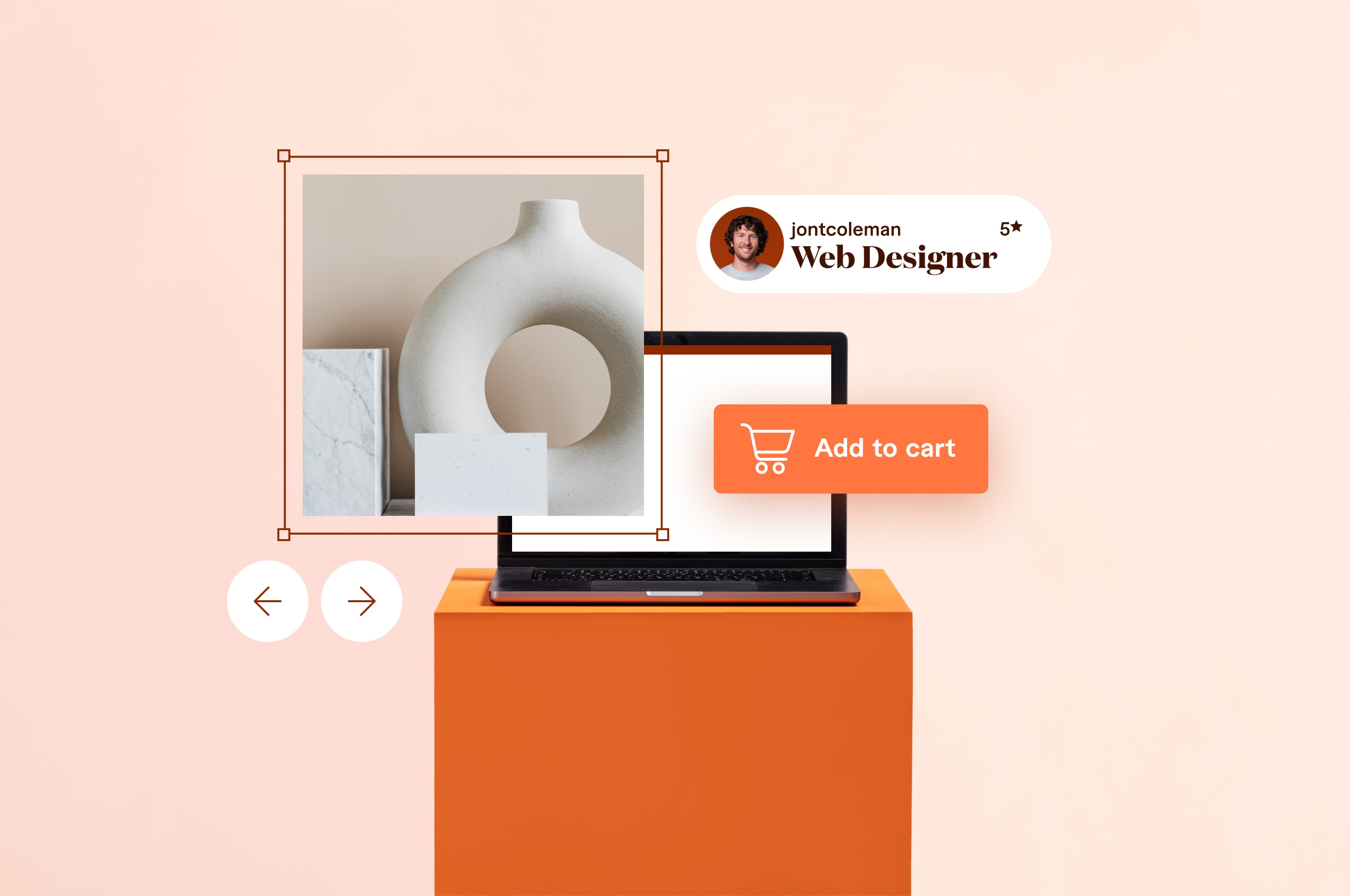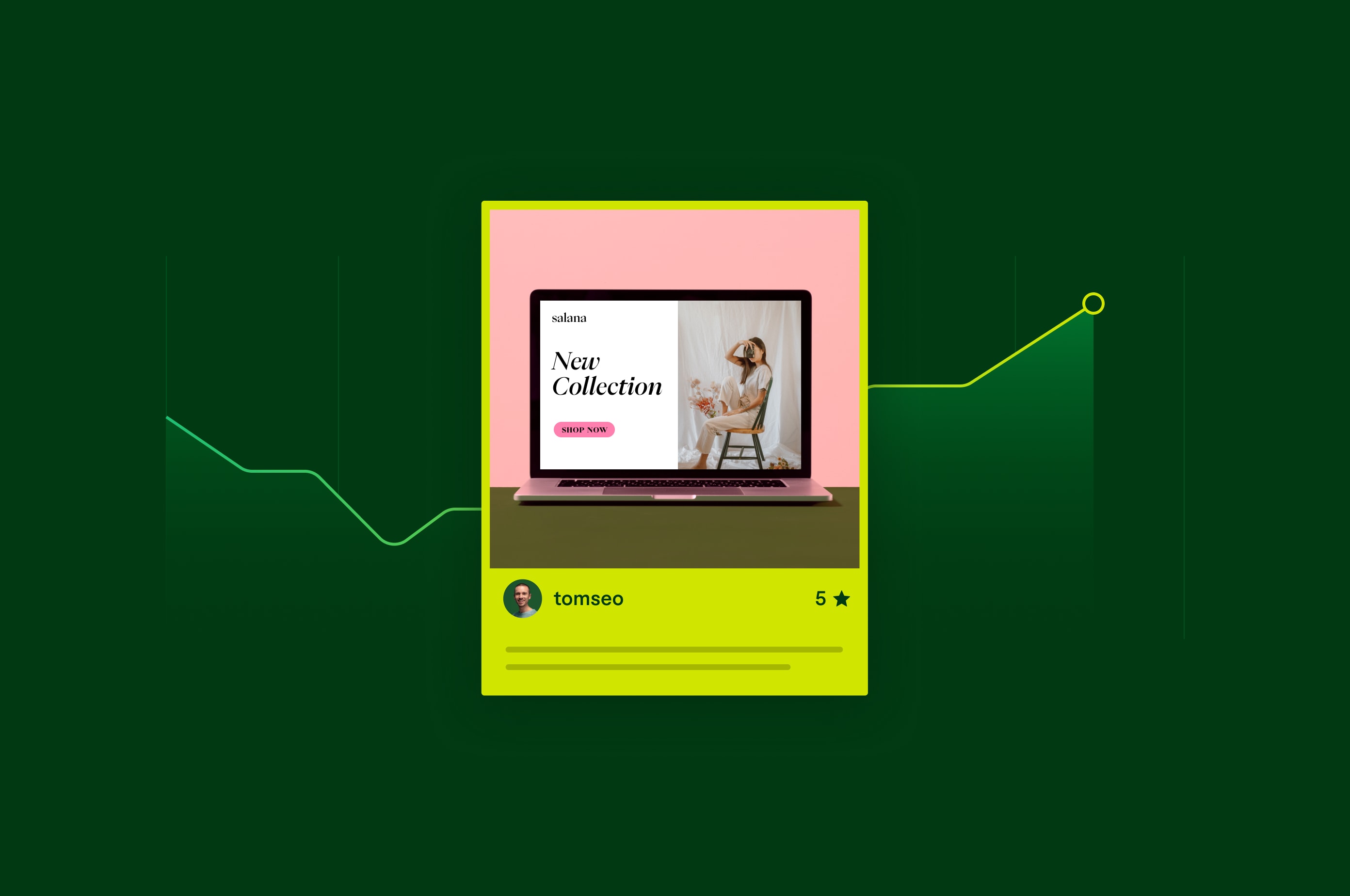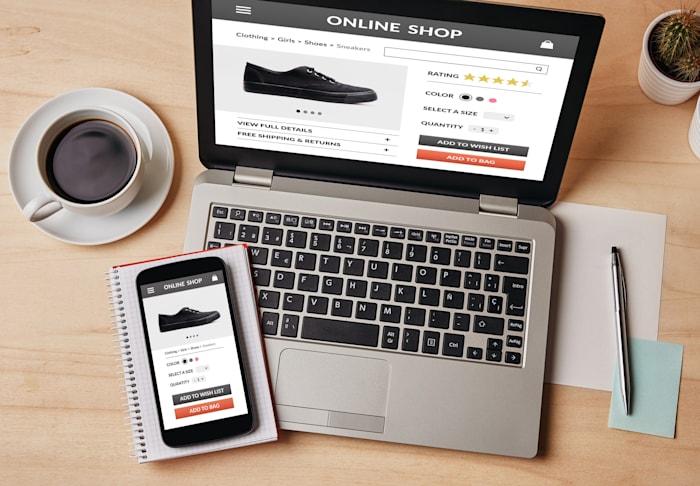22 Simple Ways to Boost Your eCommerce Conversion Rate & Drive More Sales
Struggling with low conversion rates? Discover 22 proven ways to convert more customers and drive more sales today.
 May 13, 2023
May 13, 2023 20 minute reading
20 minute reading
Increasing your eCommerce conversion rate is an awesome way to boost profitability. But knowing where to start can feel anything but easy.
If you’re new to the field of conversion rate optimization (CRO), it’s a lot to take in. So in today’s post, we’ll cover the basics of CRO.
We’ll share with you a simple lens through which to appraise your store, and show you 22 tactics you can copy to drive more conversions.
By the end you’ll have several practical ideas to drive real improvements in your conversion rate. Plus, we’ll include expert tips for your entire buyer’s journey—from speeding up your website to addingpost-purchase upsells.
What is an eCommerce conversion rate?
AneCommerceconversion ( aka transaction rate or order rate) is any action a visitor takes on your website that you want them to take. Some examples of eCommerce conversions are when customers:
View a product page
Add a product to cart
Enter their payment details
Purchase a product
Complete any other action you define (social shares, email sign-ups)
An eCommerce conversion rate (CVR) refers to the conversion rate of orders on a store (i.e. how many visitors turn into customers.) The formula looks like this:
eCommerce conversion rate = (orders / visits to your online store)*100
For example, if you have 1,000 visitors to your website and generate 30 orders, your eCommerce conversion rate is 3%—(30/1000)*100.
22 Strategies to boost your eCommerce conversion rate
We’ve organized these strategies to follow the customer journey down your sales funnel. Starting off with when the shopper lands on your website and moving closer to the purchase as we go.
Hire an Ecommerce CRO expert on Fiverr
1. Optimize site loading speed & cookie banner speed
If you’ve battled with a slow loading website, you understand the frustration. You’re not alone.Googlereported that for every second delay in mobile page load, conversions can fall by up to 20%.
Similarly, if your EU cookie consent banner is loading slowly, you can bet your bottom dollar that it’s eating into your conversion rate too.
So to test your store’s loading speed, hop over toGoogle’s PageSpeed insightstool. This free tool shows your loading speed across mobile and desktop while also suggesting ways to improve. You’d be surprised how many big brands don’t have speedy websites.
Below, I tested Scandinavian clothing brand A Day's March website. While they pass the core vitals assessment, Google recommends a number of improvements, such as compressing images—especially on mobile.
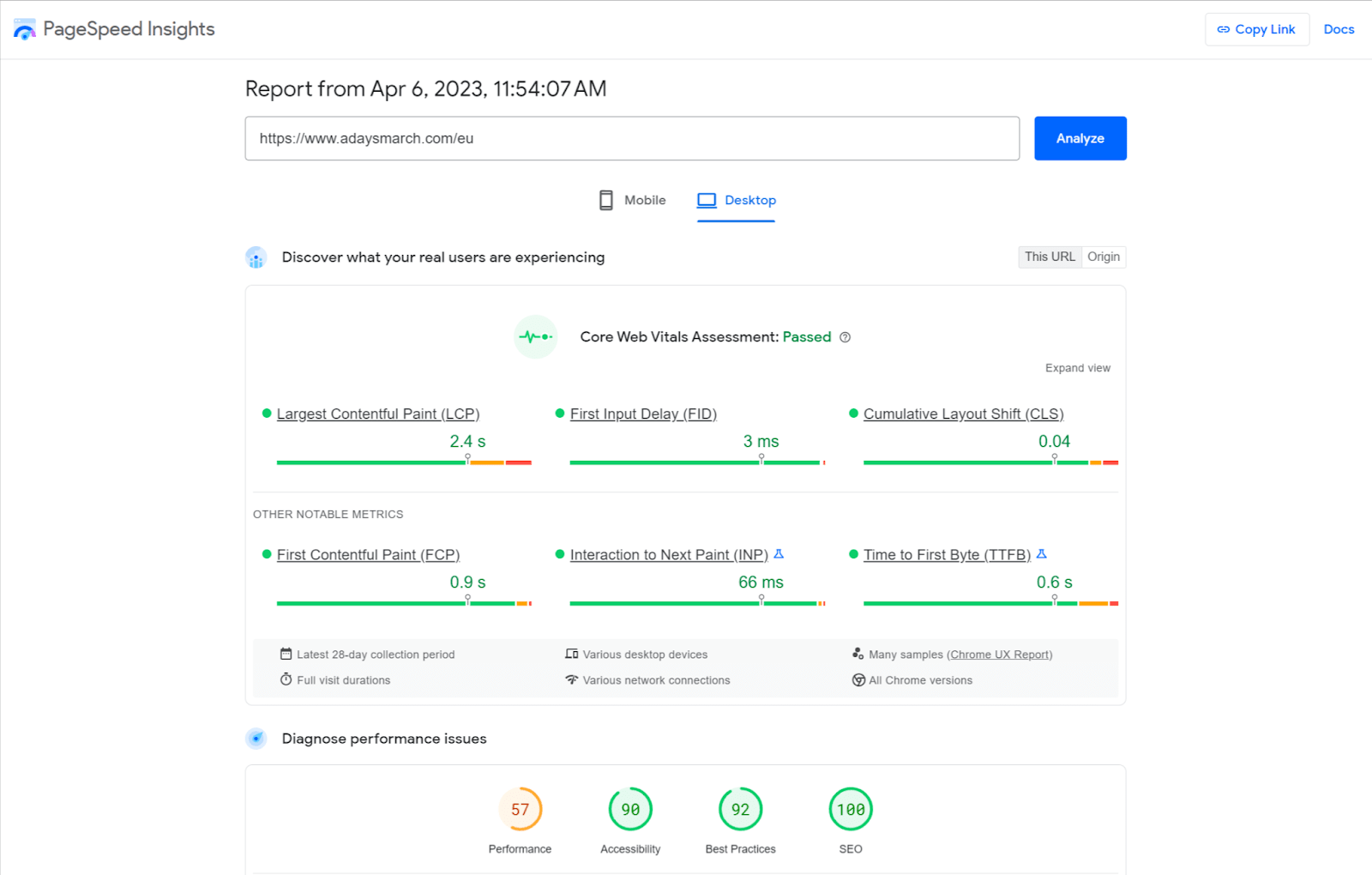
If you’re unsure how to make the improvements Google suggests, you’ll find plenty of experienced FiverreCommerce consultantsto get the job done.
2. Make it easy to find the right product
Making it easy for shoppers to find what they’re looking for is essential.
“Reducing the cognitive load by assisting users in choosing a relevant product, and providing confidence they have made the correct decision, is proven to provide noticeable uplifts in CTR and CR,” says Sammy Fraser, head of digital strategy at Swanky.
For example, YuMOVE identified users exiting its site on the collection page due to having choice overload and no clear way to decipher between products. So Sammy implemented prompts at the top of the product tiles to promote the benefit and intended use of the product. This simple change resulted in a 4.68% increase in CR.
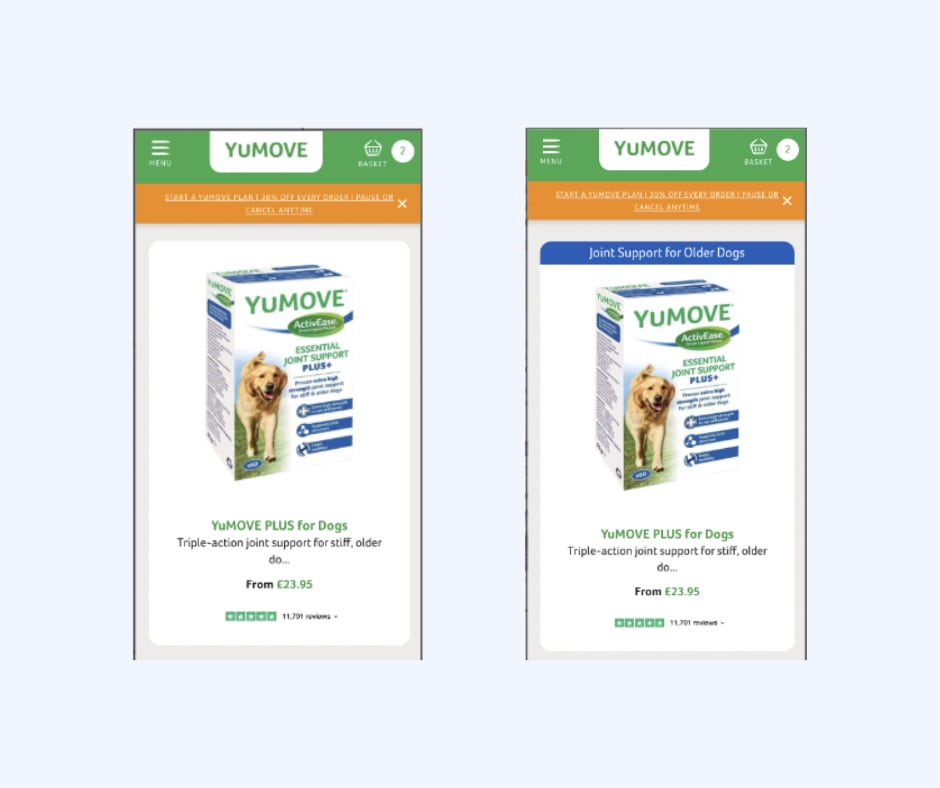
You'll find a lot of CRO optimization strategies, sometimes small changes can yield very big results.
3. Design a ‘broad & shallow’ navigational structure
Navigating through a brick and mortar store is easy. Without a clear and logical navigational structure, online customers can easily get lost, and revert back to Google.
A broad and shallow approach works best. This means organizing your store’s structure so no page is more than 3 clicks deep.
Take Gymshark, for example. Despite having a large array of products, its website navigation starts with just two options—men’s and women’s.
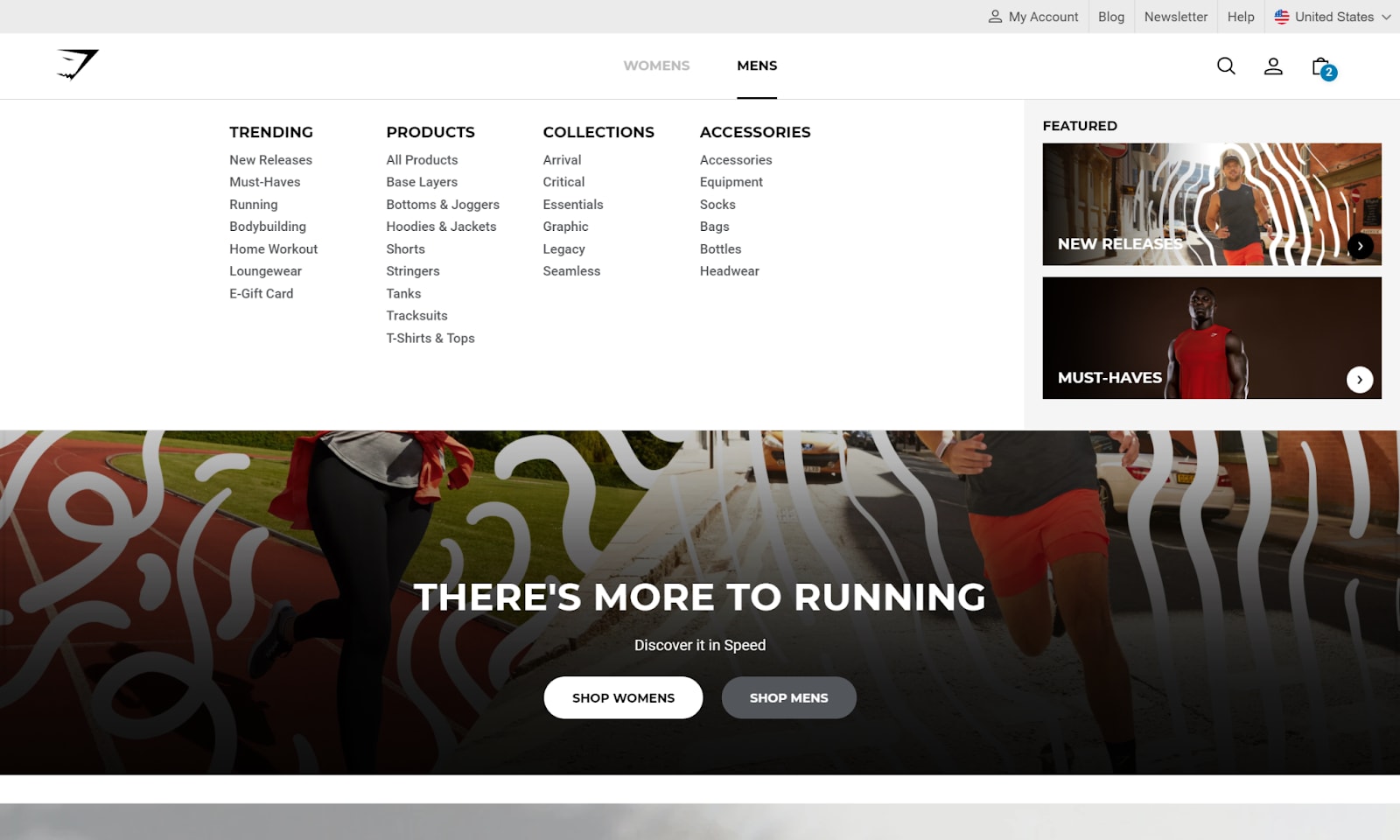
From there shoppers see a dropdown menu, allowing them to browse by products, collections, trending, and accessories. You don’t need to take more than 3 clicks anywhere on its site to land on a product page.
This simple shallow structure makes it easy to navigate to the relevant section, prevents visitors from getting lost, and maximizes conversions.
4. Implement a search bar and filters
On-site search provides potential shoppers with the most efficient customer journey, especially if you carry a large product inventory.
For example, instead of rummaging through Lululemon’s extensive category pages, its smart search bar directs shoppers to whatever they’re looking for.
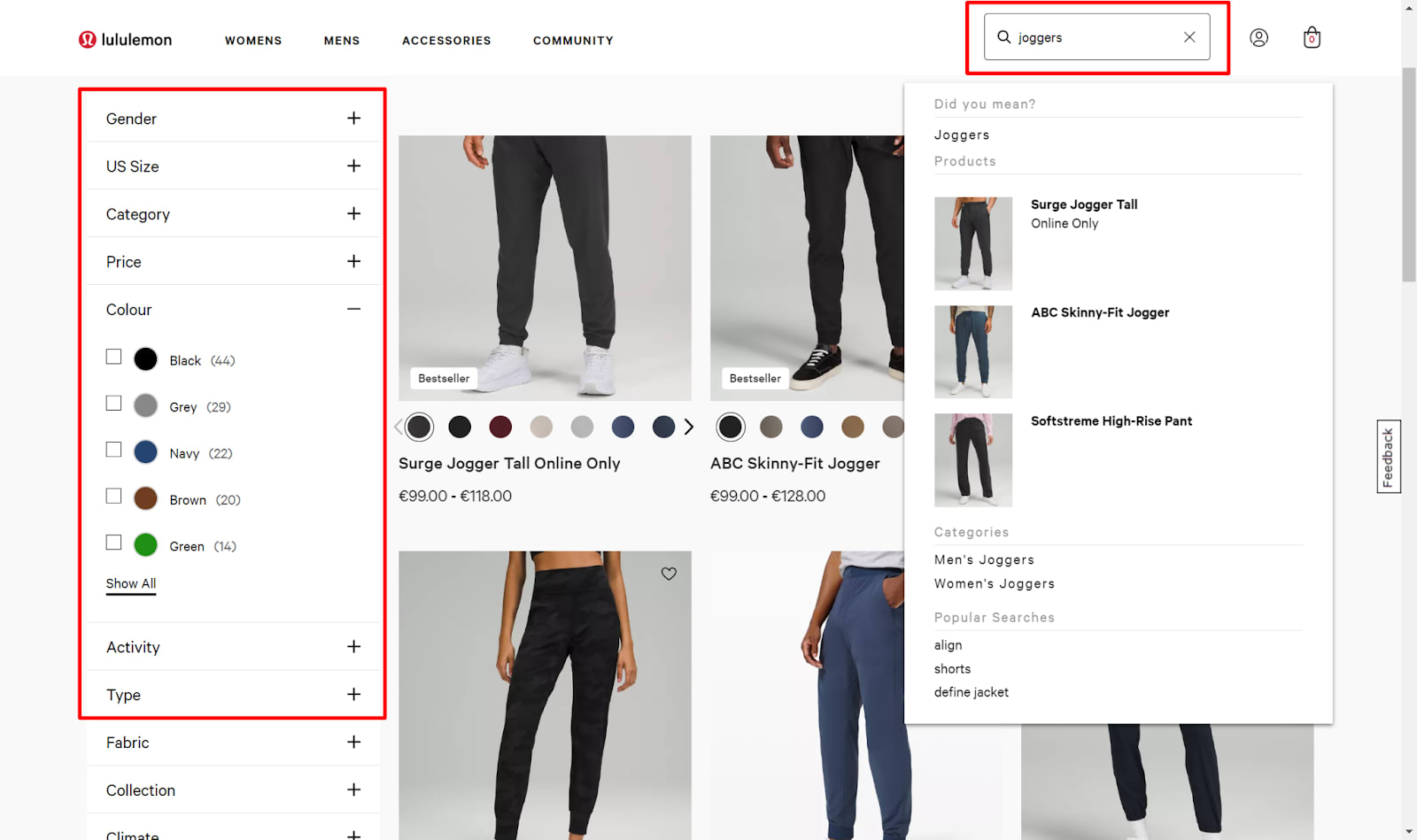
On top of search, adding filters to your search results and category pages streamlines the process further. Visitors can zero-in on the type of product they’re looking for and enjoy a smoother shopping experience.
5. Add a CTA to your 404 page
One simple way to boost your conversion rate is to include a call to action on your 404 page. For example, if watch brand MVMT’s customers click a broken link or accidentally enter its URL incorrectly, they’ll end up here:
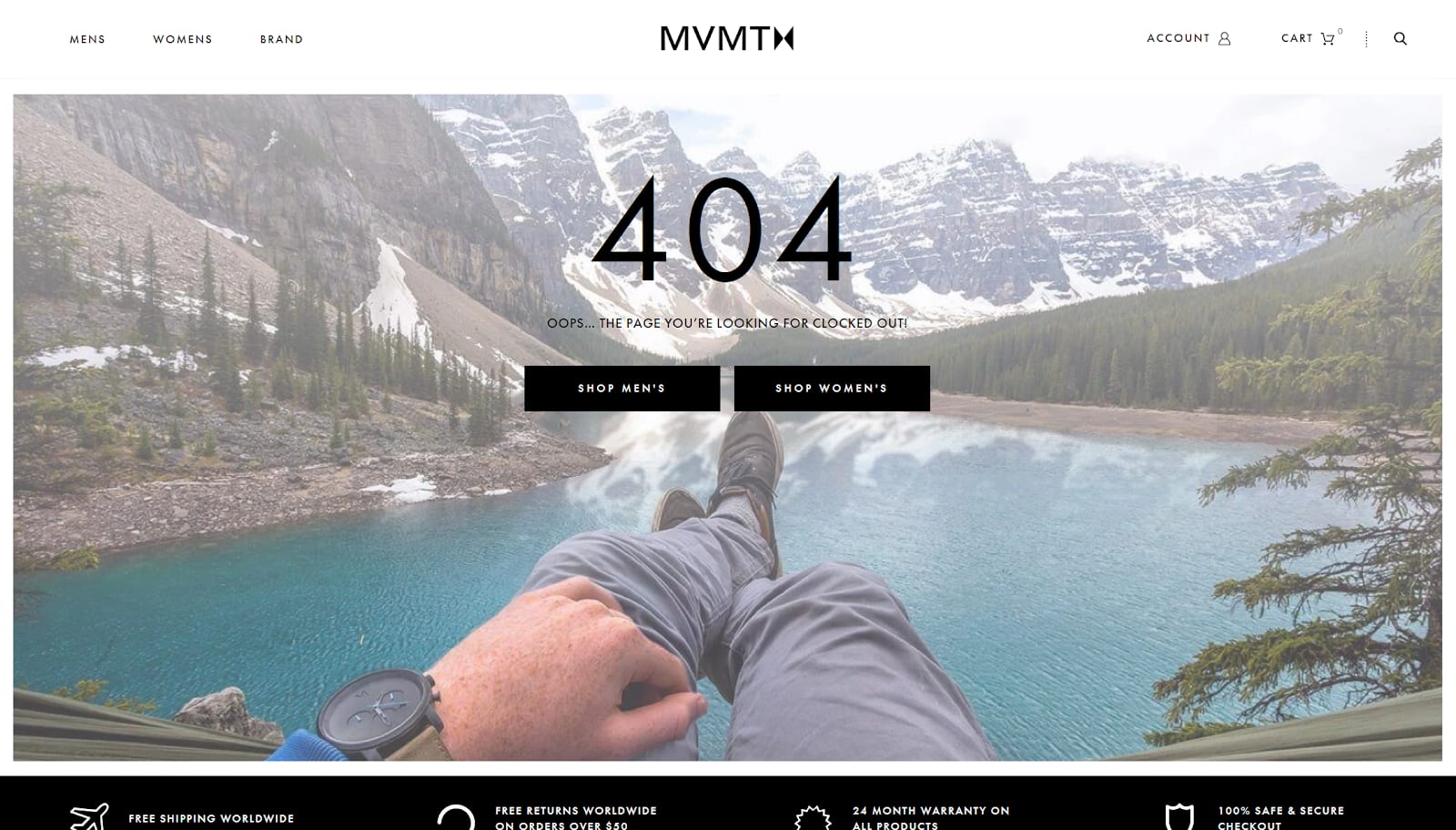
现在,而不是一个页面,每个客人要g to bounce, MVMT makes it easy for shoppers to navigate back to its store and resume their buyer’s journey with minimal interruption.
6. Optimize your product page
Your product page is where the magic happens. It’s one of the most critical conversion stages of your customer journey.
And despite different brand’s product pages looking very different from each other, the successful ones all share similar characteristics.
Here’s an example of a high-converting product page from one of thebest Shopify stores, Allbirds:
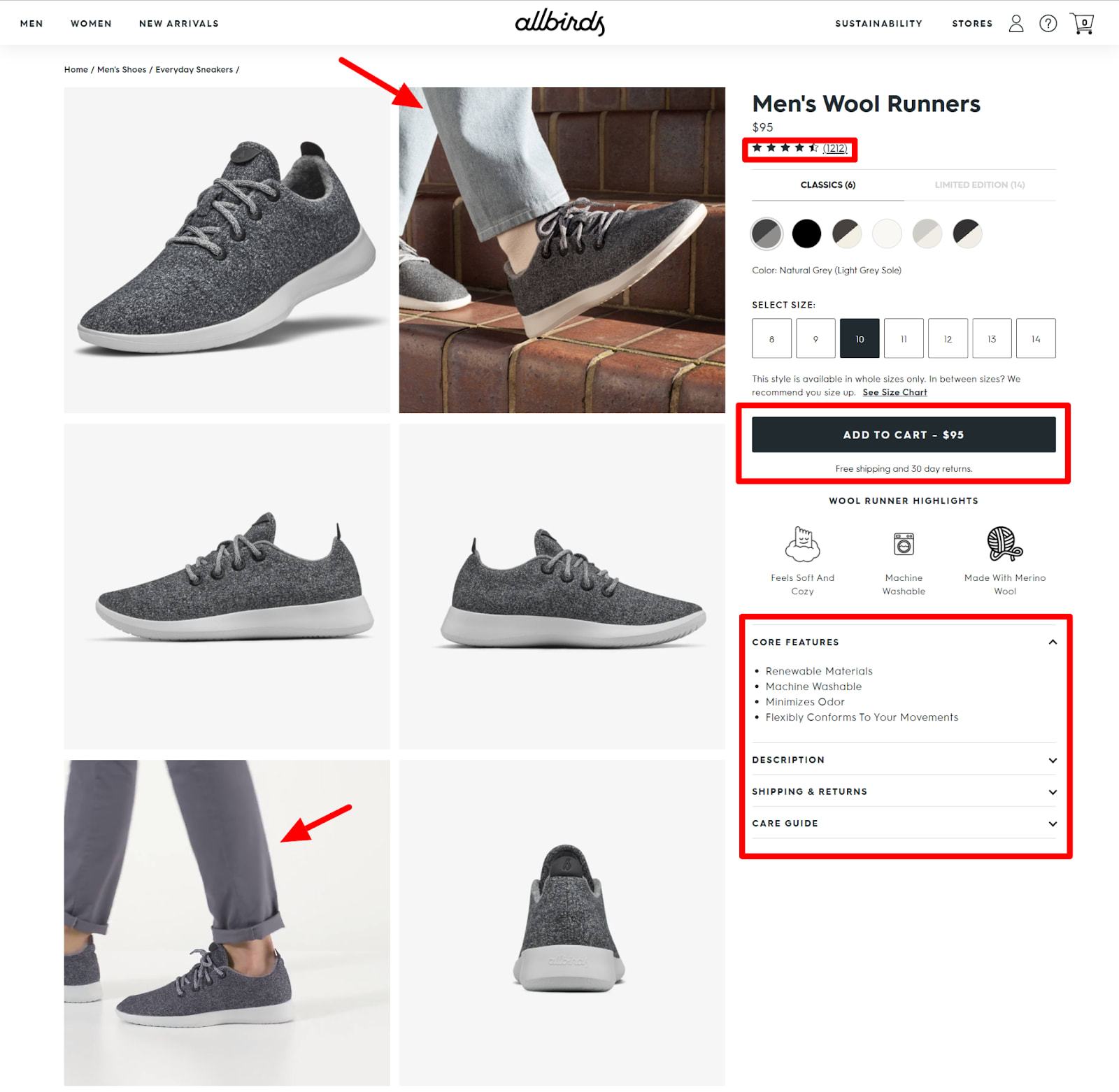
There’s a few elements that we can learn from here:
Multi-angle product images:Gives shoppers a sense of what the shoes are like in real life. Notice how they use a mixture of lifestyle and pure product photography.
A compelling description:Quickly give all the information shoppers need about the shoes. As you scroll down the page, there's a more extensive description and more images.
A clear CTA button:Stands out against the background—the next step is clear to the shopper.
Customer reviews:Adds social proof to give customers the confidence to buy knowing other people are delighted with their order.
Shipping & returns info:Highlights free shipping & free returns beneath their CTA to maximize conversions.
Think about how you can optimize your product page. Do you communicate your USP clearly? Are customers missing any information they need to make a decision? Why should people trust your products are good? Asking questions like this determines where you need improvement.
专家提示:Did you know around 80% of people say product photos are the most important factor when buying online? If you need help getting it right, consult with aproduct photographeron Fiverr to create beautiful images for your store.
雇佣一个产品今天摄影师为你的商店
7. Emphasize benefits over features
When it comes tocopywriting, many merchants make the mistake of leading with product features over product benefits.
Product benefits often appeal to our emotions and have a more powerful impact on conversions.
For example, notice how Best Self doesn’t describe its journal by using details like "durable hardcover construction." Instead, it emphasizes it can help you become more productive and accomplish your biggest goals.
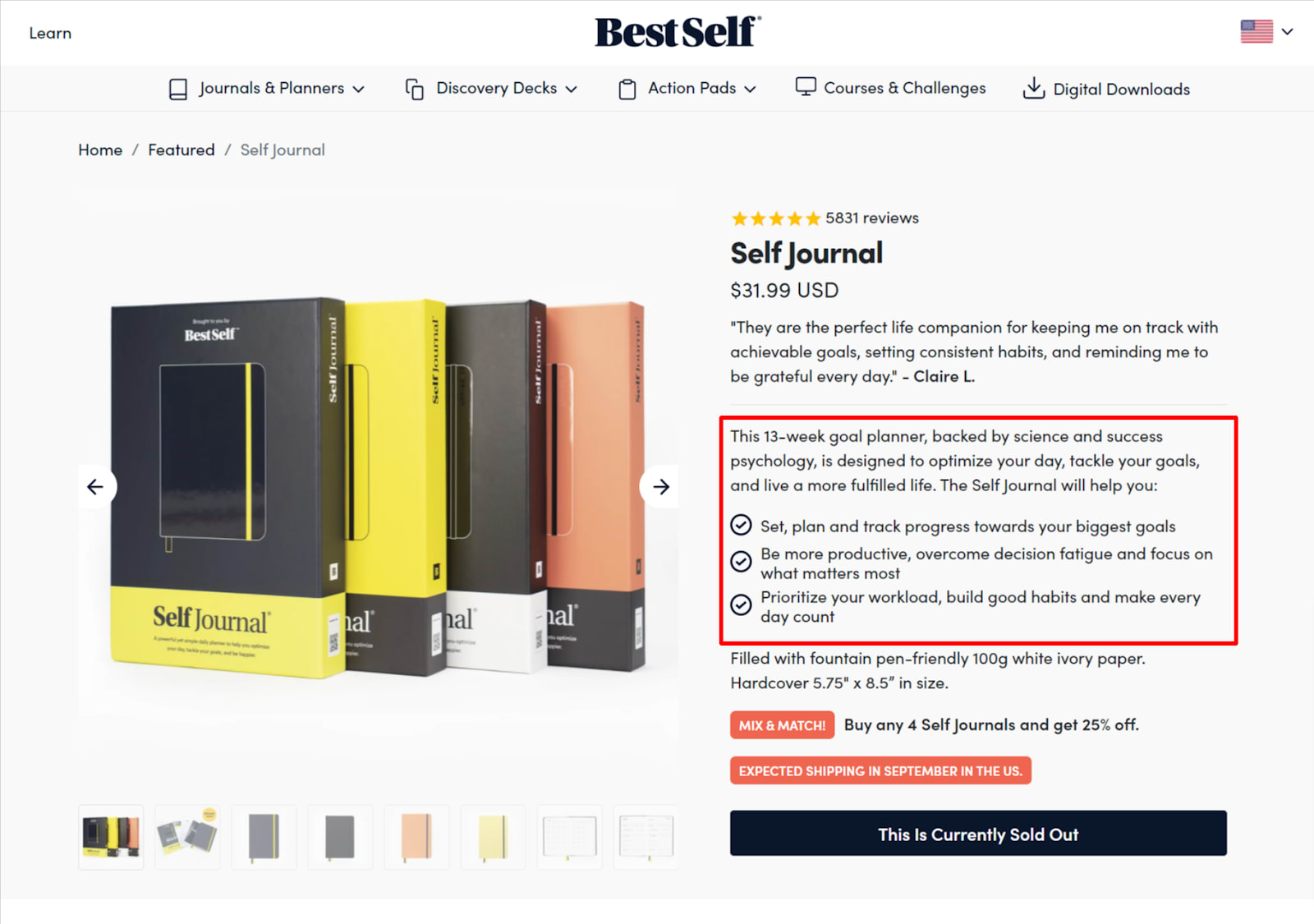
To tease out the benefits of your products use the "so what" method:
Draw 3 columns on a sheet of paper
In column 1, make a list of your product’s features
Then look at each feature and ask ‘So what, why does that matter?’
Write your answers in column 2
Now, look at each answer in column 2 and ask ‘So what, why does that matter?’ again
Write your answers in column 3
This nifty copywriting device will help you drill down into the real motivation and desires your customers have for buying your products.
8. Leverage social proof
Social proof is the phenomenon where people imitate actions of others to display socially accepted behavior. For conversions, social proof is an anxiety-reducing balm.
“As customers we buy products that make us feel good about ourselves, products that change us and make us better,” saysTalia Wolf, CRO expert. “By using social proof in the form of testimonials, reviews and trust icons you’re helping customers make a decision, feel confident about their choice, and be a part of something bigger,” adds Wolf.
在你的商店的情况下,添加通过cust社会认同omer reviews, testimonials and media mentions. Here’s how Athletic Green’s does it:
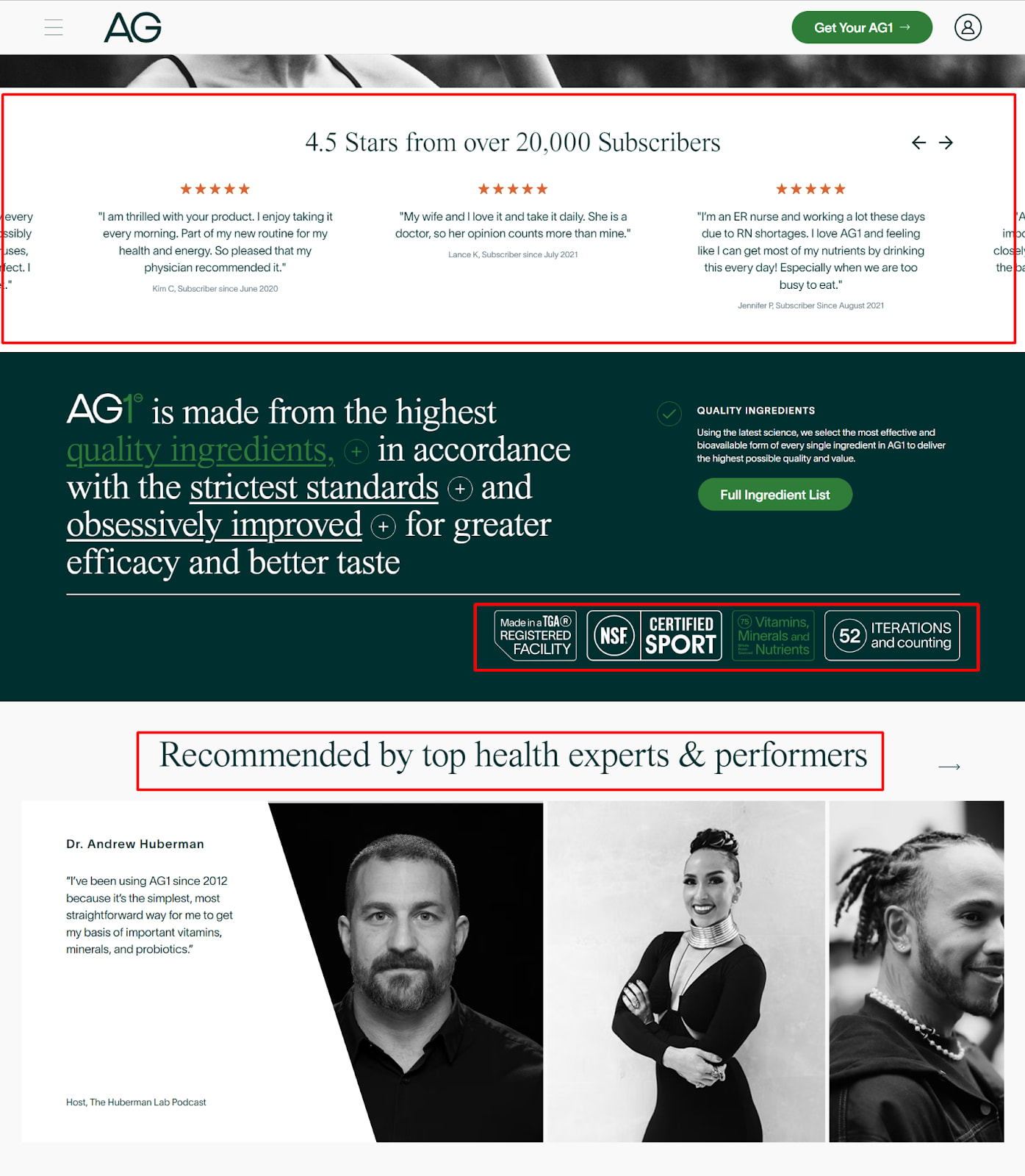
See how its customer’s reviews, certifications, and expert testimonials lend legitimacy to the product?
“One clever way to use social proof to build an automated system that collects social proof from your customers,” notes Tim Kock, Head of Marketing at Shopify App, Loox. “Since shoppers spend most of their time on visual-first social media platforms like TikTok and Instagram. This means you have to invest heavily in content creation.”
According to Kock, tackling both problems at the same time and addingvisual reviewsare the way to go. Photo and video reviews not only build more trust than text-only reviews, they also provide valuable marketing visuals. Add them to your store and you’ll see conversions explode.
9. Add subtle scarcity and urgency
During the mid-1970s, a group of researchers—Worchel, Lee, and Adewole—conducted an experiment to gauge human behavior towards jars of cookies.
The study participants were divided into two groups. One group was presented with a jar brimming with cookies, while the other group was shown a jar containing only two cookies. Which jar of cookies do you think participants found more desirable?
If you guessed the jar with only two cookies, you’re correct.
The study concluded that humans have an inherent inclination towards valuing scarce items more highly. Additionally, the study found that this tendency is even stronger when people perceive the scarcity to be due to high demand.
So how does this apply to your eCommerce business? Well, check out how clothing brand Everlane, re-creates this ‘nearly empty cookie jar’ effect:
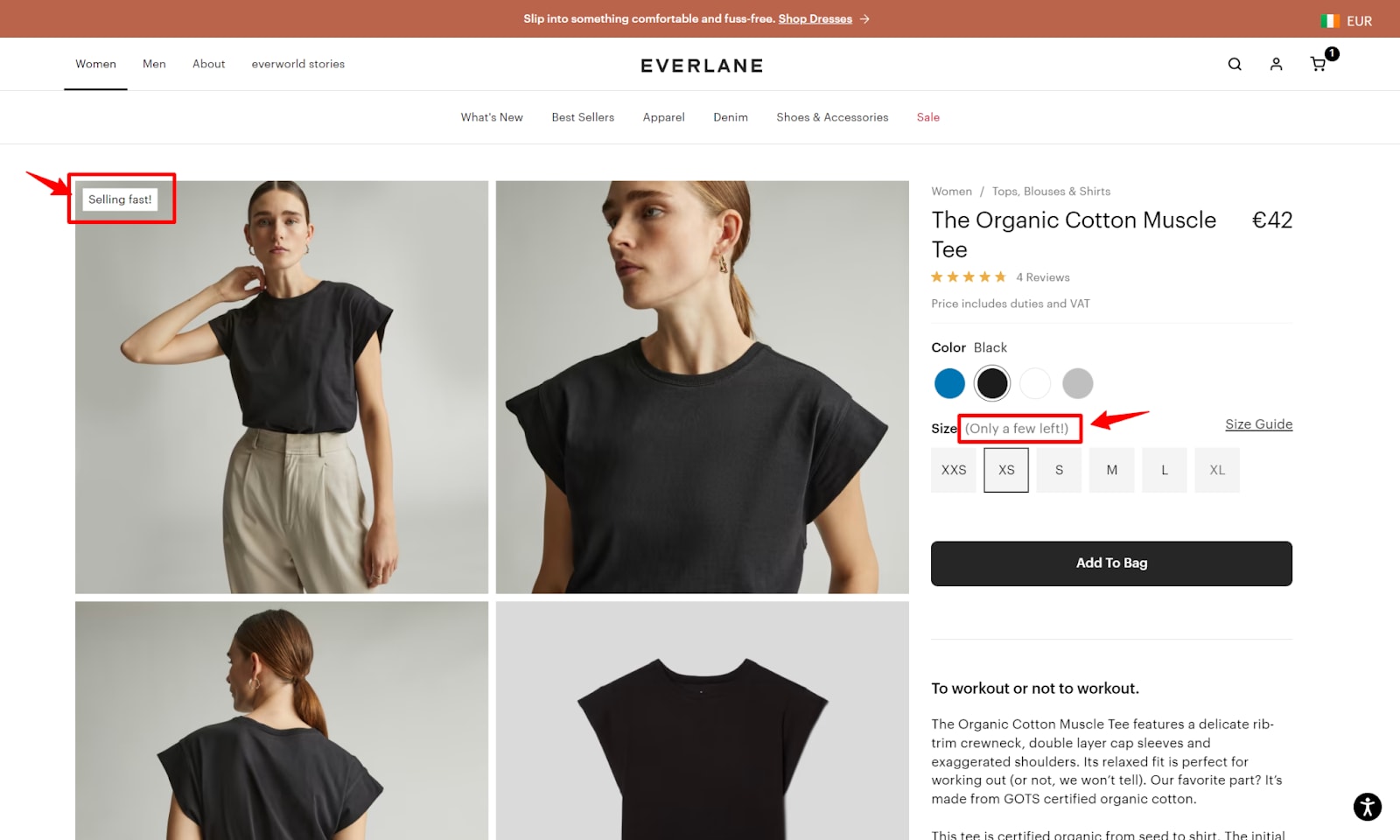
It lets their customers know their popular products are selling fast, and uses stock counters to remind customers that there’s only a few left.
It also added a little "Psst Get it now before it sells out" to its cart drawer too.

Other ways to add a sense of urgency include:
Countdown timers
Flash sales
Reserving carts for a limited time period
But be careful, too much scarcity and urgency, or implementing it in a spammy or dishonest way, may damage your brand’s reputation.
10. Offer payment plans
Sometimes parting with a lump sum is a psychological barrier for customers, especially if you’re selling pricier products.
Payment plans allow customers to split up their purchase into more manageable chunks. Furniture brand Made uses Klarna to give customers the option of splitting their payment. This lowers the immediate commitment required from customers.
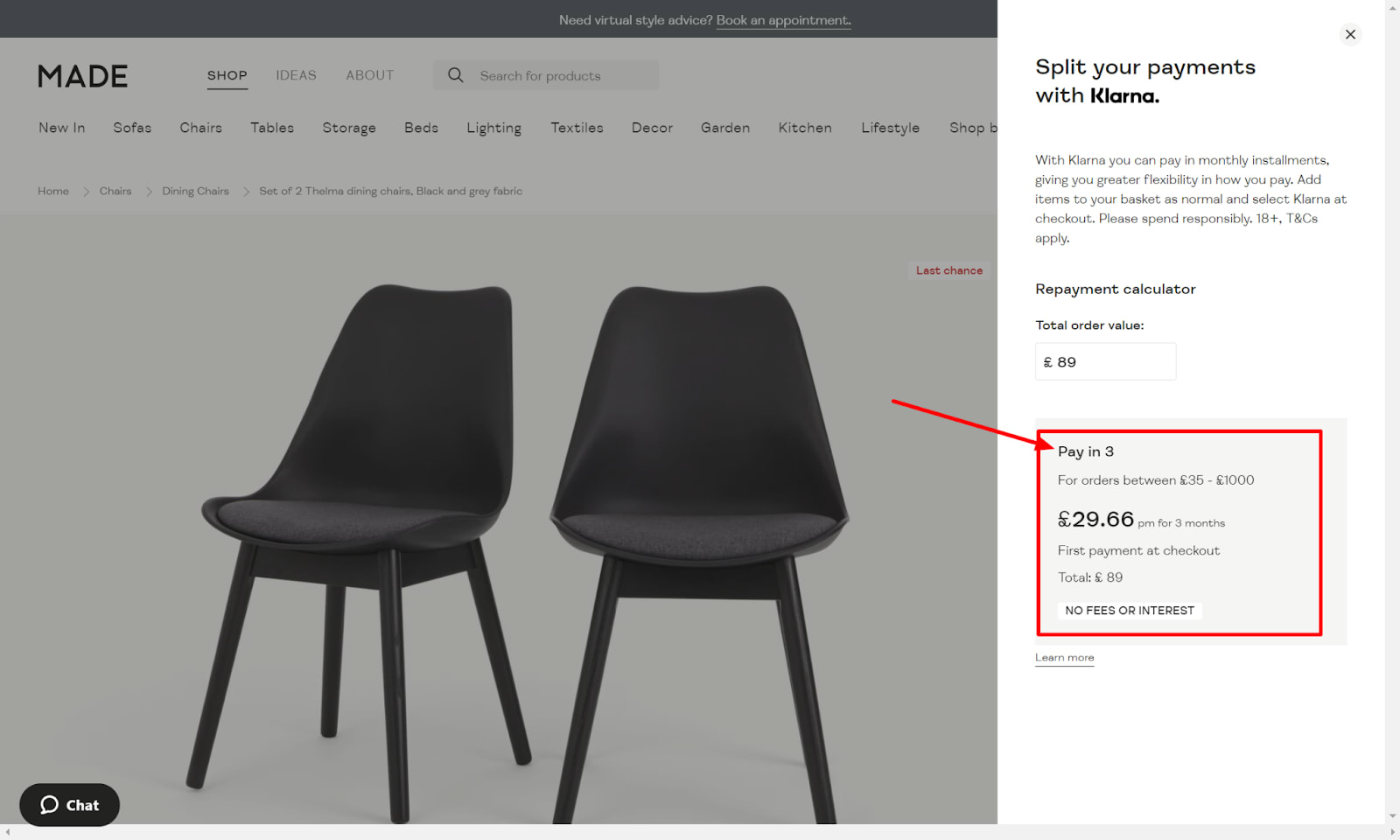
Remember from our CRO framework above, one of our aims is to lower shopper anxiety. When a customer only has to pay $30, instead of $90 upfront, you can expect more conversions.
11. Add an exit-intent pop-up
The humble exit-intent pop-up isn't to be scoffed at. Use a tool like Poptin to show a tempting offer to customers when they're about to click away from your site or close their browser.
Here’s an example from Athletic Greens that offers to send customers a coupon code in exchange for their email address:
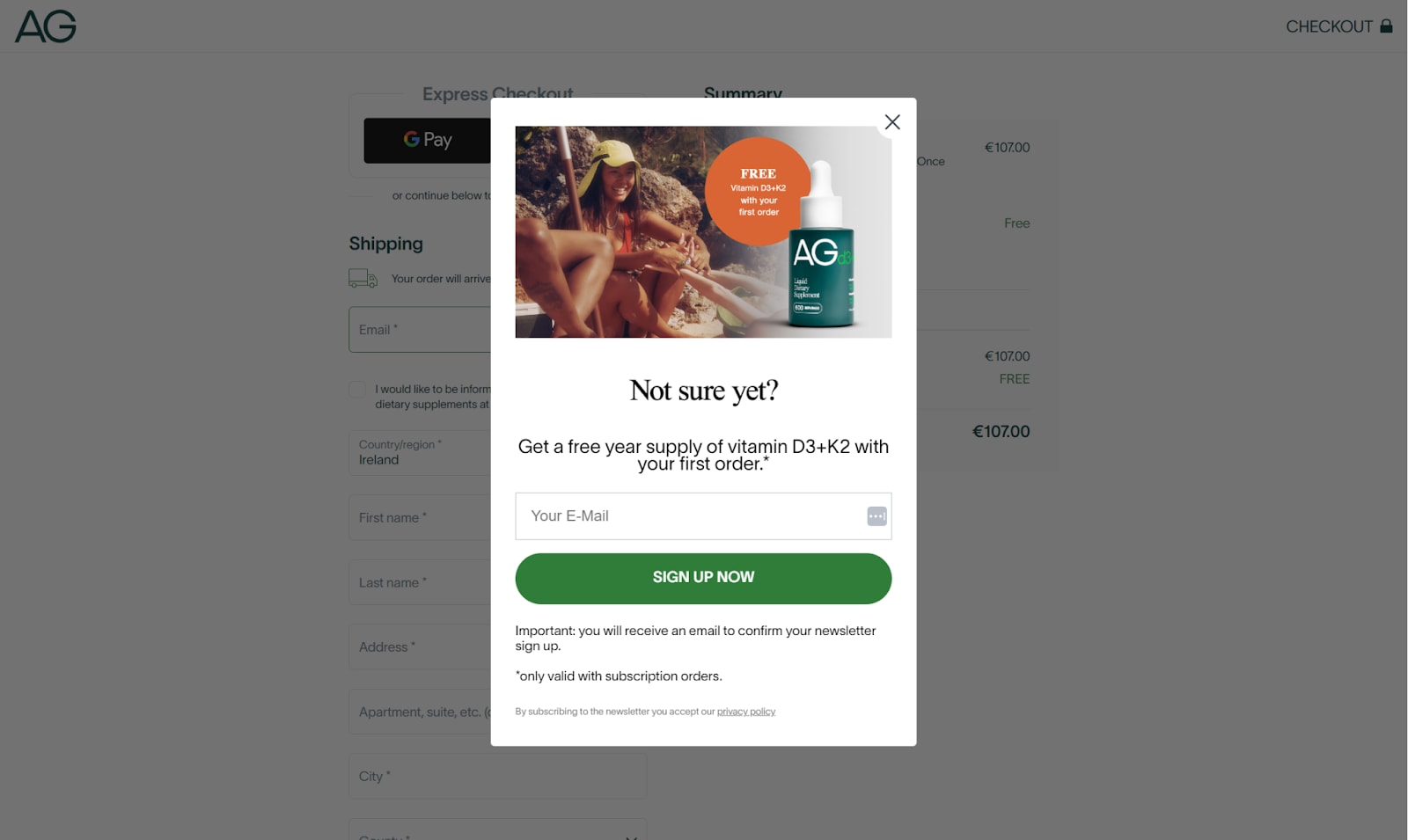
While you may have temporarily lost the purchase conversion, you’re still getting a conversion in terms of an email sign-up. Capturing customers' emails like this allows you to continue to market to site visitors and nurture them until they’re finally ready to purchase.
12. Offer free shipping and returns
The biggest reason for cart abandonment is unexpected fees at checkout. This makes sense—if you think you’re going to buy something for $50 and then at checkout the subtotal is $65, there’s a mismatch between expectations and reality.
Similarly, many shoppers are anxious about purchases that'll be hard to return
.One solution is to offer free shipping and free returns to offset the friction caused by shipping fees and the anxiety caused by a poor returns policy.

If it’s not possible to build shipping fees into your product prices and offer free shipping, consider offering a free shipping threshold. This will encourage customers to spend more and boost your AOV.
在哪里设置免运费门槛?它te your median order value and set your threshold about 20% above that to nudge the bulk of your customers to a higher basket value.
13. Offer a new customer discount or free gift
So we know unexpected fees at checkout are the number one culprit when it comes to cart abandonment.
But what if you flip that purchase barrier into a purchase facilitator by applying a discount code to first-time customer’s carts like Everlane does:
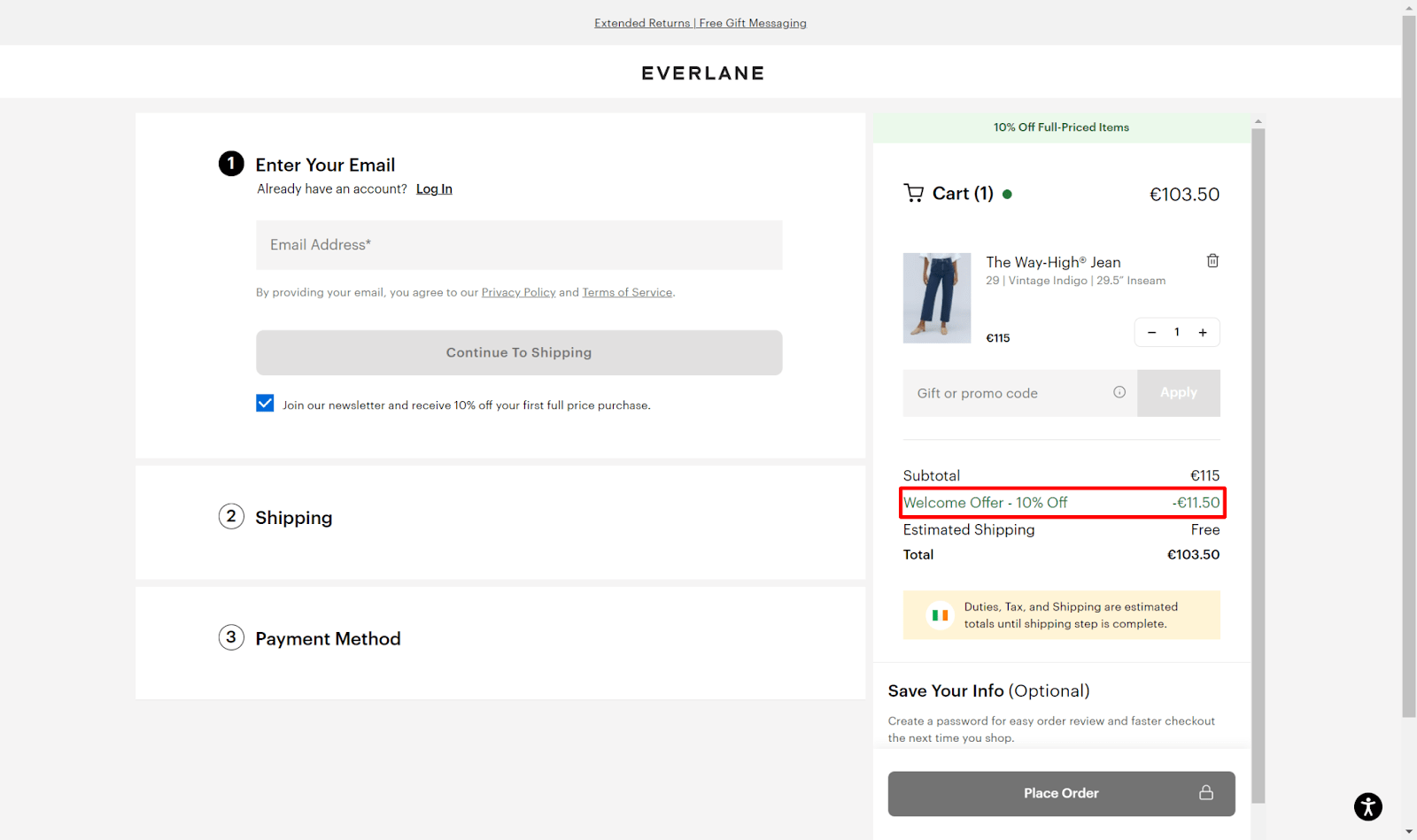
The total price is unexpected. But it’s unexpectedly lower than the shopper anticipated, giving new customers the boost they need to convert.
Athletic Greens implements a similar strategy where it adds a free gift to the cart to delight first-time shoppers:
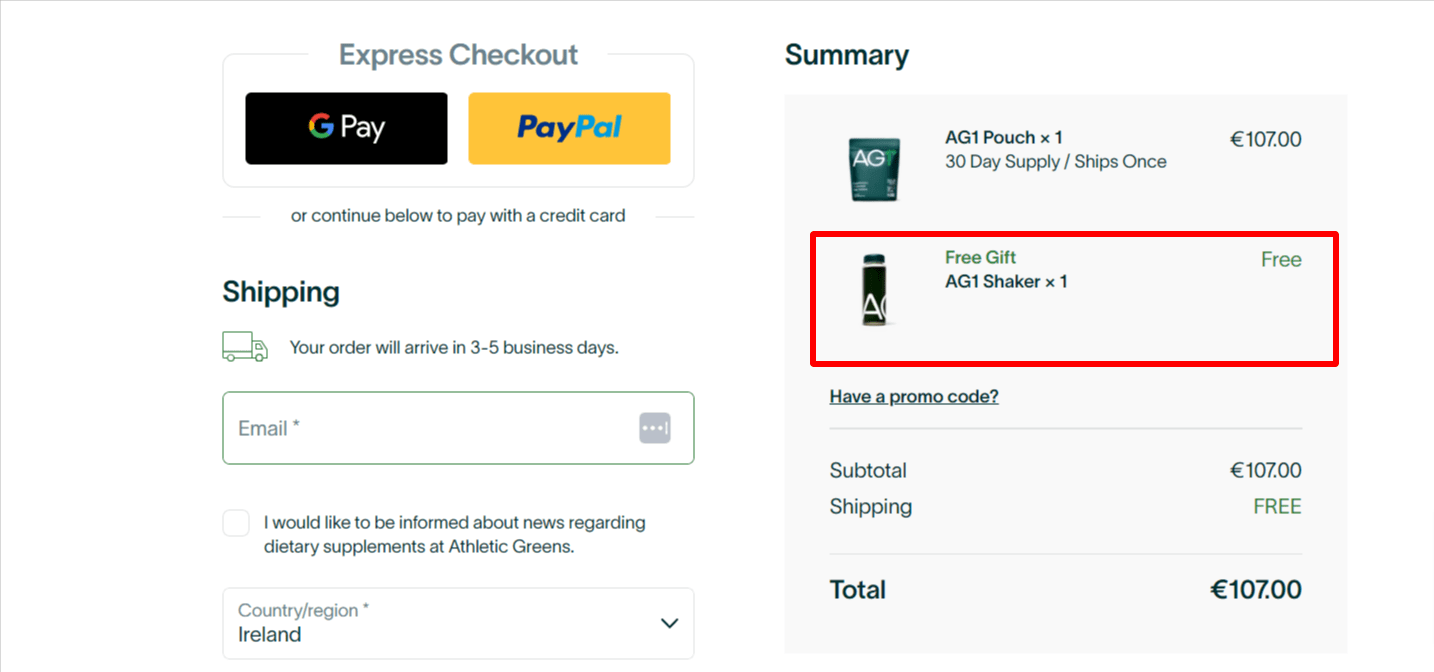
Think about how you can give customers unexpected benefits (rather than speed bumps) and watch your conversion rate rise.
14. Upgrade your cart page
The cart page is often overlooked by retailers. However, this critical step in the conversion process deserves more attention.
Check out how pizza oven retailer Ooni modified its cart page to boost conversions:
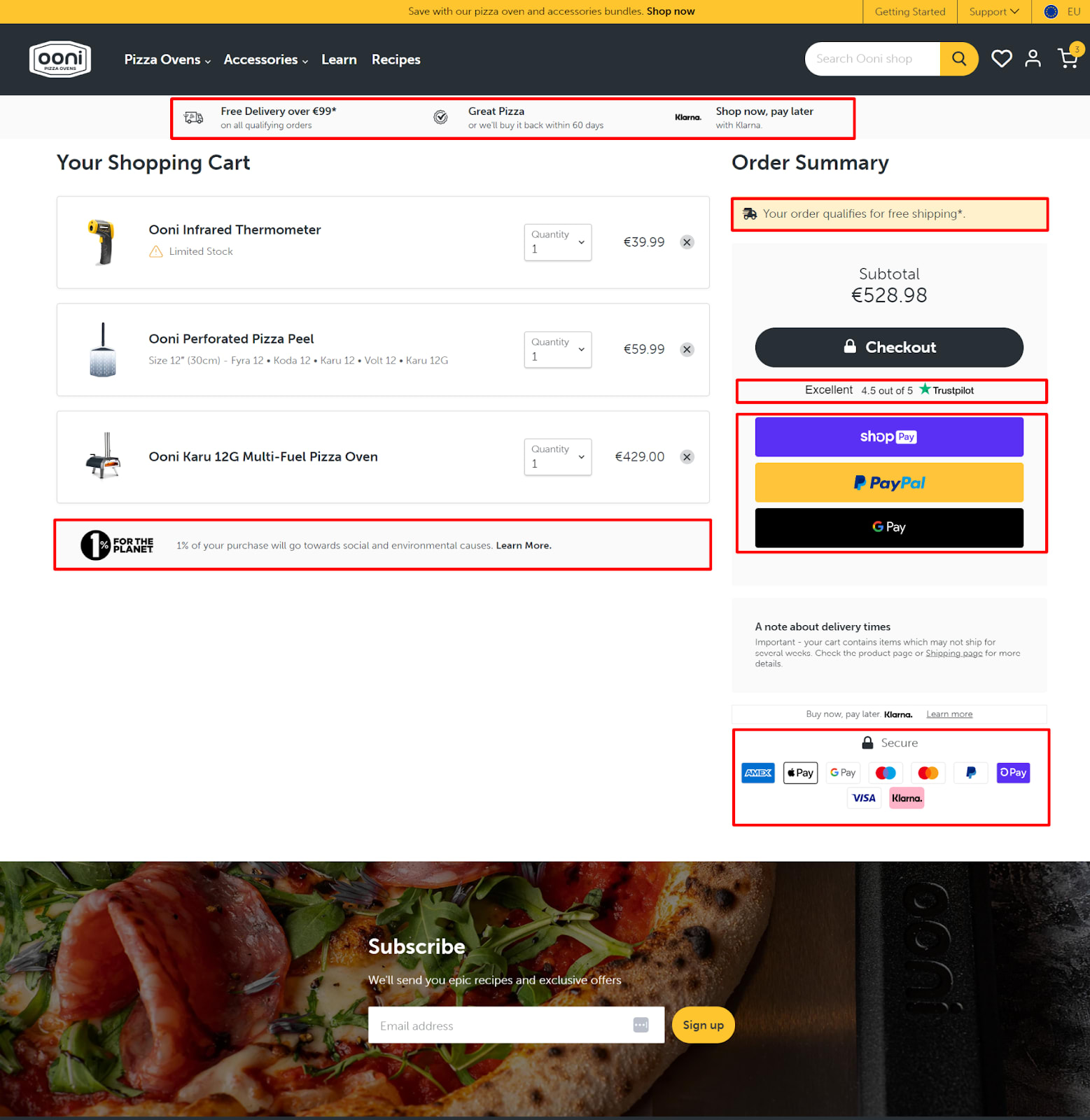
At the top, it reminds customers of the benefits of shopping there—free shipping, 60-day return policy, and split payments with Klarna.
It also includes social proof by displaying its Trustpilot score and the recognizable logos of various reputable payment companies.
Customers can pay using multiple payment options, including express checkouts which allow them to bypass the tedious form filling.
Lastly, Ooni highlights that it's a responsible charitable business by displaying the 1% For The Planet logo.
All in all, it’s a powerful cart page that brings together many of the elements that push customers towards completing their purchase.
15. Send abandoned cart emails
The vast majority of people who add a product to cart, end up abandoning their cart (somestudiessuggest it’s a high as 80%).
And while enticing shoppers back is tricky, a solid abandoned cart email can seduce up to 10% of cart abandoners back to complete their purchase.
That makes abandon cart emails one of the most valuable automations in youremail marketingarsenal and for boosting your conversion rate.
But if you’ve ever tried, you’ll know that writing a good abandonment email can be tricky. So here’s a great example from Brooklinen:

This email is part of a three emails series. In the first email, sent soon after abandonment, Brooklinen reminds customers that they didn’t complete their purchase.
In the second, two or three days later, Brooklinen gives customers a time-limited discount of 10%. And then lastly, customers receive the scarcity-driven email above reminding customers that their discount is about to expire.
It’s a nice way to create multiple reminders and incorporate a sense of urgency into your abandoned cart email flow.
16. Add visual progress indicators to checkout
Merchants often avoid checkout for fear of tanking their conversion rate, But with the right expertise, you can implement changes that drive your conversion rate upwards.
When increasing your checkout conversion rate, add progress indicators to the top of the page like Taylor Stitch do here:
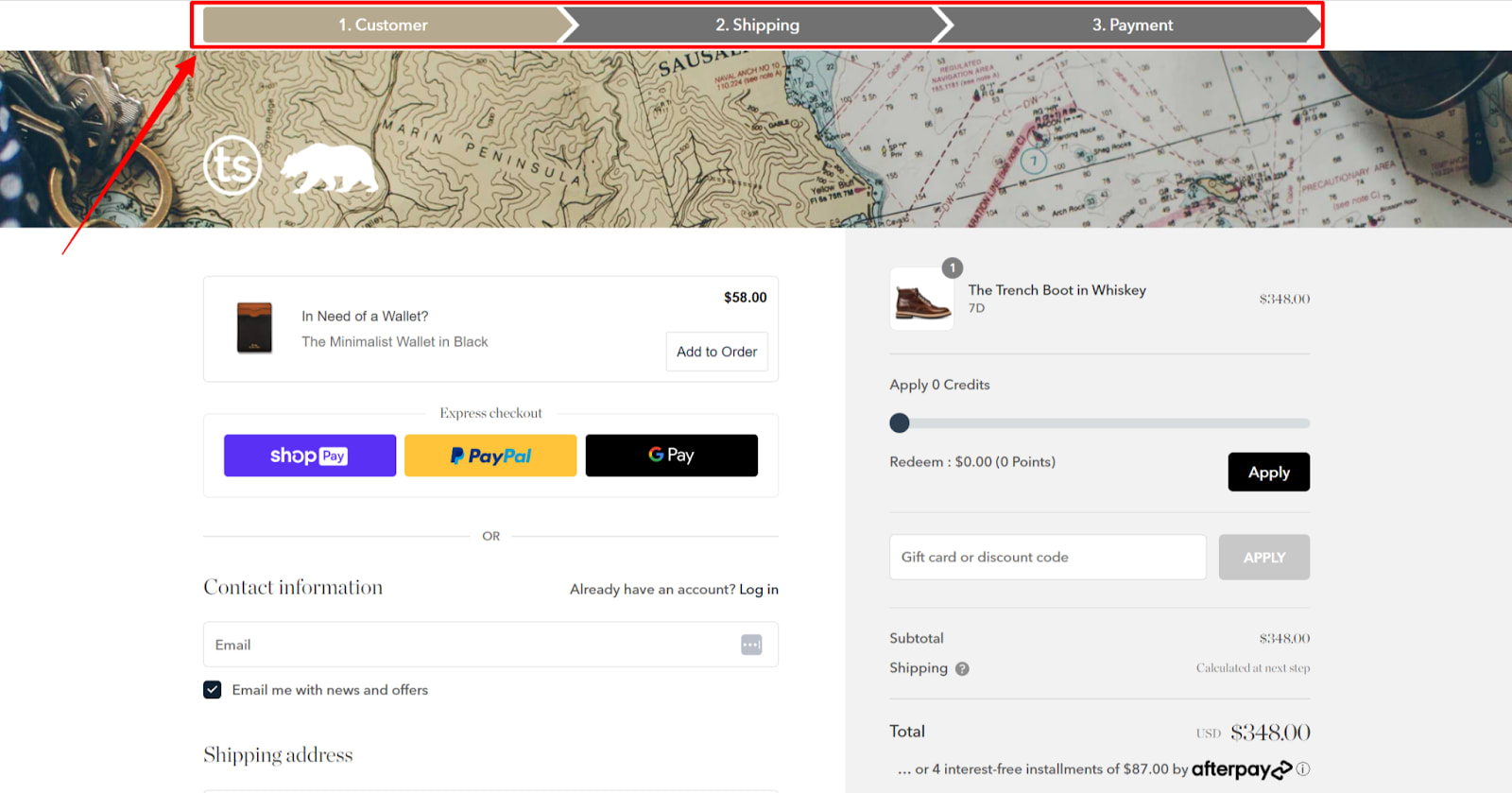
“By providing a clear indication of how far along users are in the checkout process, it creates a sense of accomplishment and progress, which can increase motivation to complete the purchase,” says Yusuf Shurabaji, Co-Founder & Partner at Prismfly. “This drives higher conversion rates and ultimately revenue.”
17. Remove ‘return to cart’ links from checkout
When customers initiate the checkout process, remove any distractions or links that can interrupt the flow."We've run AB tests, which took minutes to set up, including hiding the 'Return to cart' link in checkout since users can rely on their browser 'back' button or the breadcrumb,” says Shurbaji.
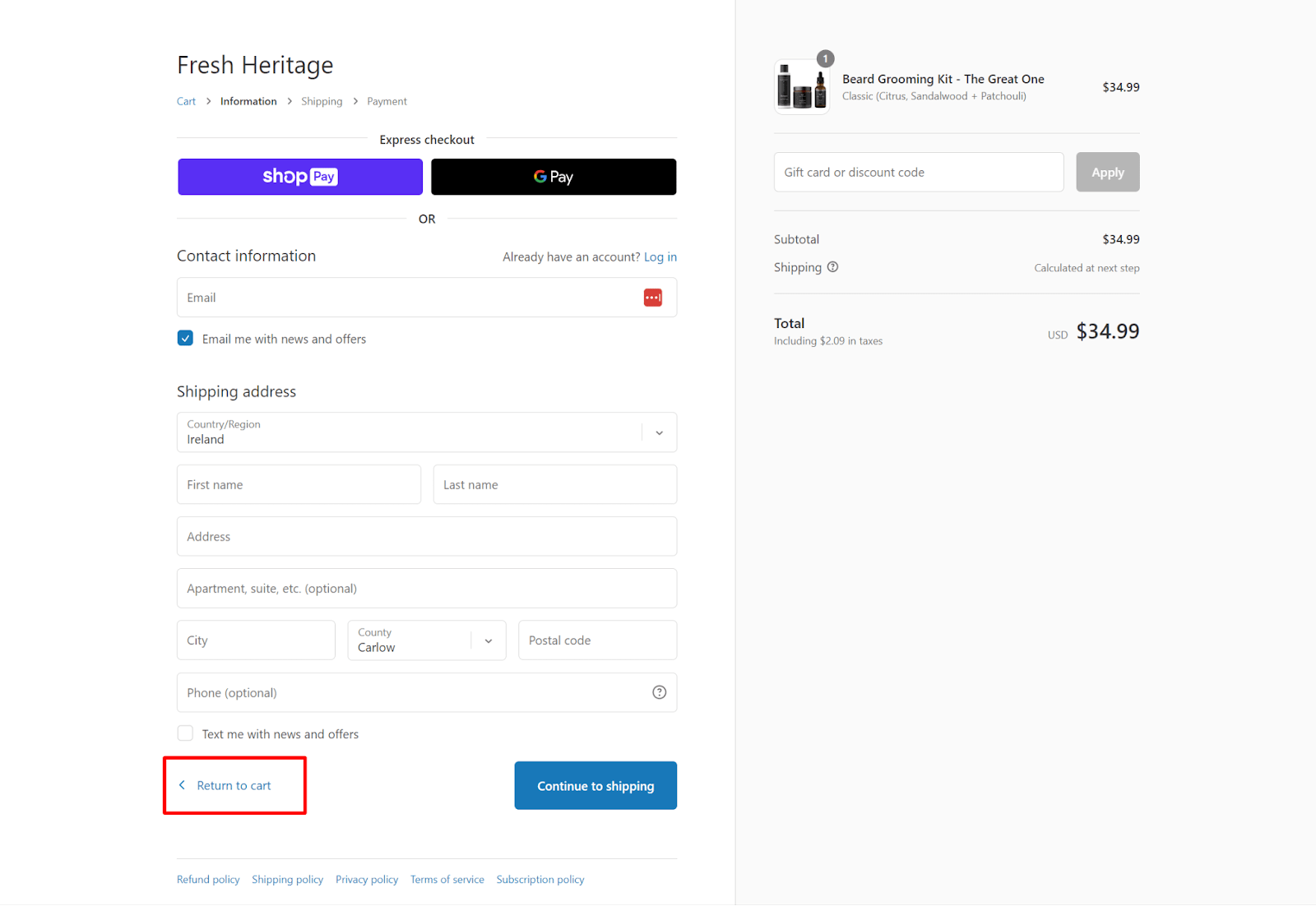
This change also increased order volume by up to 10% with over 95% statistical significance for Prismfly. So this is another super simple change that can yield significant results.
Find an eCommerce specialist for hire
18. Only ask for essential information
Long forms create friction. They require more mental effort to complete. For every extra field you make customers fill in, you can expect to see a drop in conversions.
Look at how leather goods brand Sandqvist chop its form down to size with just seven fields. It also made the shipping and payment address the same by default—a nice trick to save shoppers from entering their details twice.
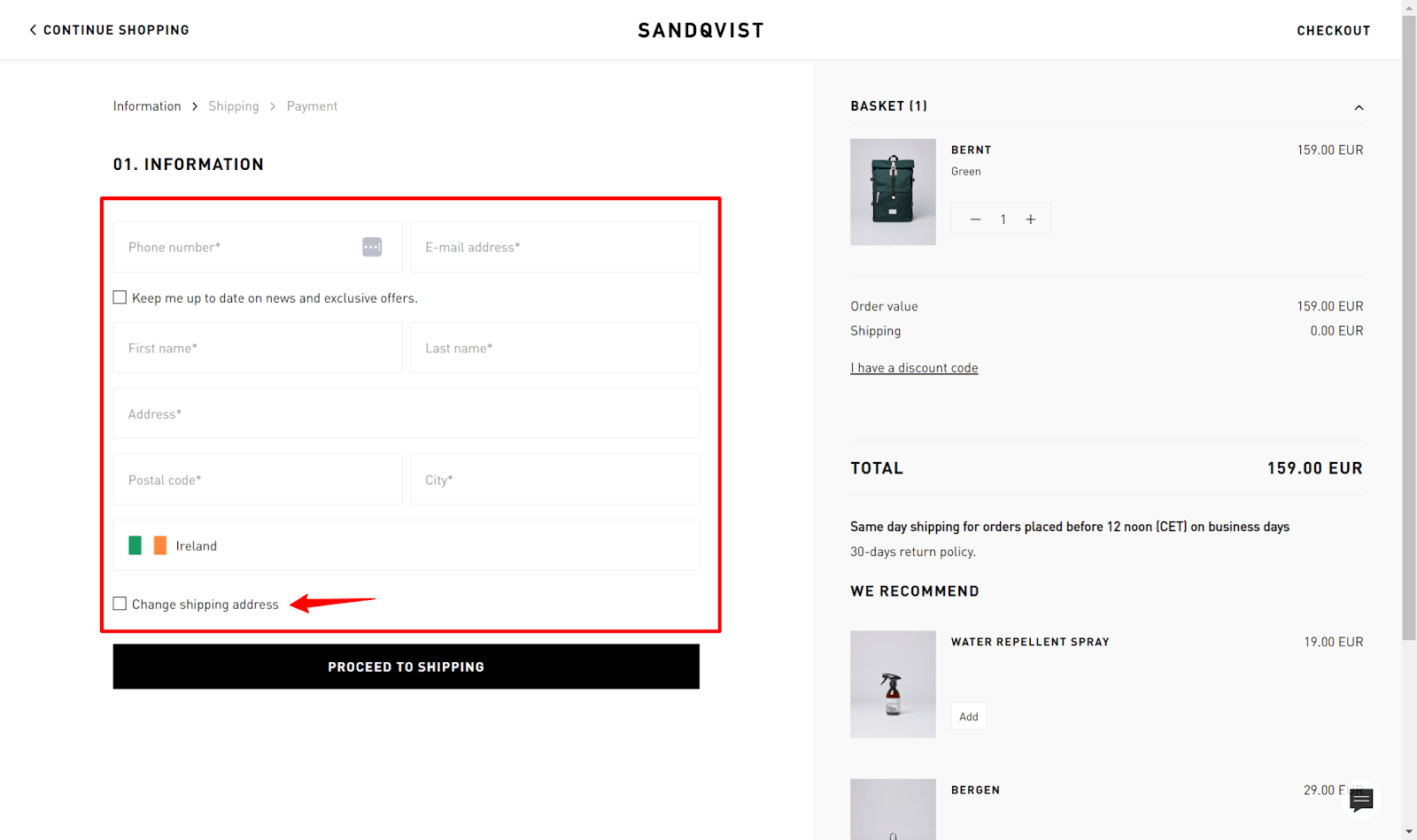
Only ask customers for the information you need to complete their order. Hide or remove any unnecessary form fields, such as ‘company name’, ‘confirm email’, ‘title’ and ‘phone number’ (where primary contact is by email).
19. Enable guest checkout (but offer account creation post-purchase)
Customer accounts are a double-edged sword for eCommerce marketers. On one hand, they provide a rich supply of customer data. On the other hand, they increase the friction for first time customers.
So what’s a merchant to do?
“Don't gate your checkout behind an account because it's a frustrating barrier," advises Shurbaji. "Instead, promote account creation when it's most valuable i.e. after purchase—where creating an account is a means of saving and re-accessing valuable information later."
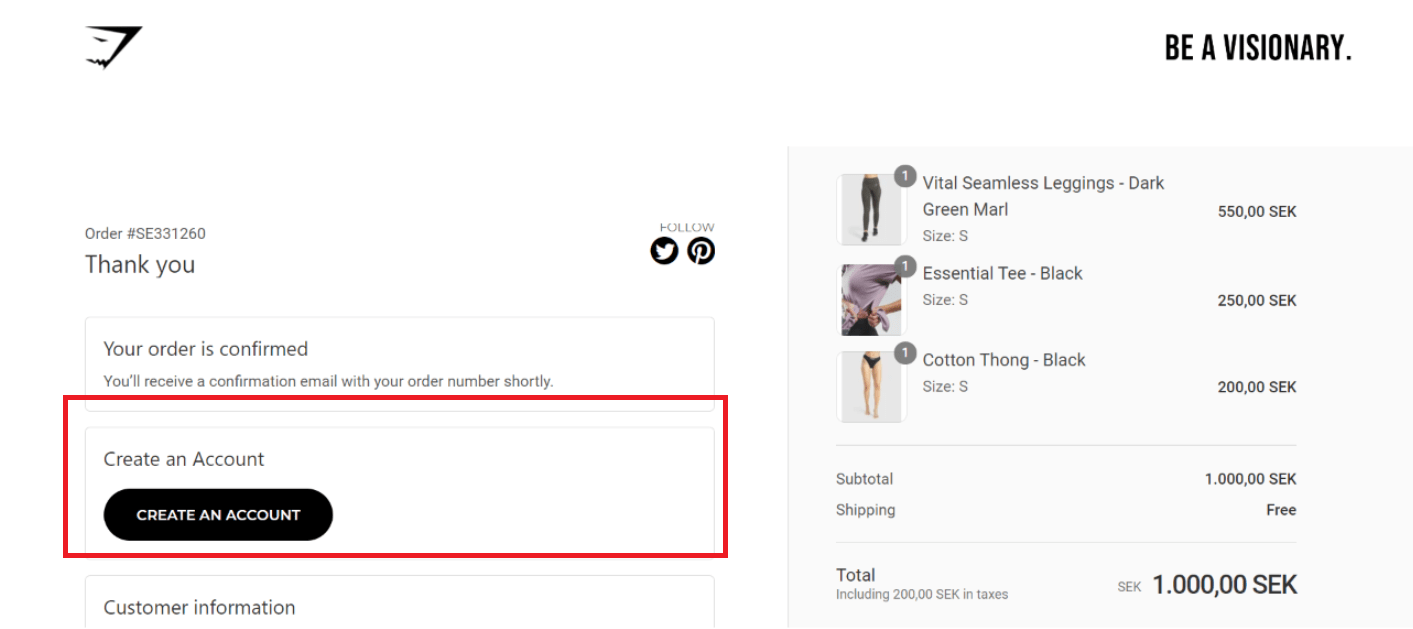
Steal this tactic from Gymshark, which allows customers to create an account immediately post purchase on its thank you page. That way you keep your checkout slippery for new customers, but make it easy for them to create an account when the sale is already secured.
20. Provide customer support at checkout
Ever been in a physical store and suddenly have questions about the product you want to buy? Well, the same thing happens in eCommerce stores, only there’s typically nobody to ask.
That’s where customer support at checkout comes in. Should shoppers have any last-minute questions regarding shipping, returns or anything else, a support agent can put their fears at bay and guide them to purchase.

21. Add one-click upsells
For many merchants, CRO optimization ends once a sale is made. However, adding one-click upsells immediately post-purchase can massively boost your average order value.
You’ve already captured that first sale, so your post-purchase offer won’t distract shoppers from the checkout flow. Then with one-click upsells, customers don’t have to re-enter their payment details—less friction equals more conversions.
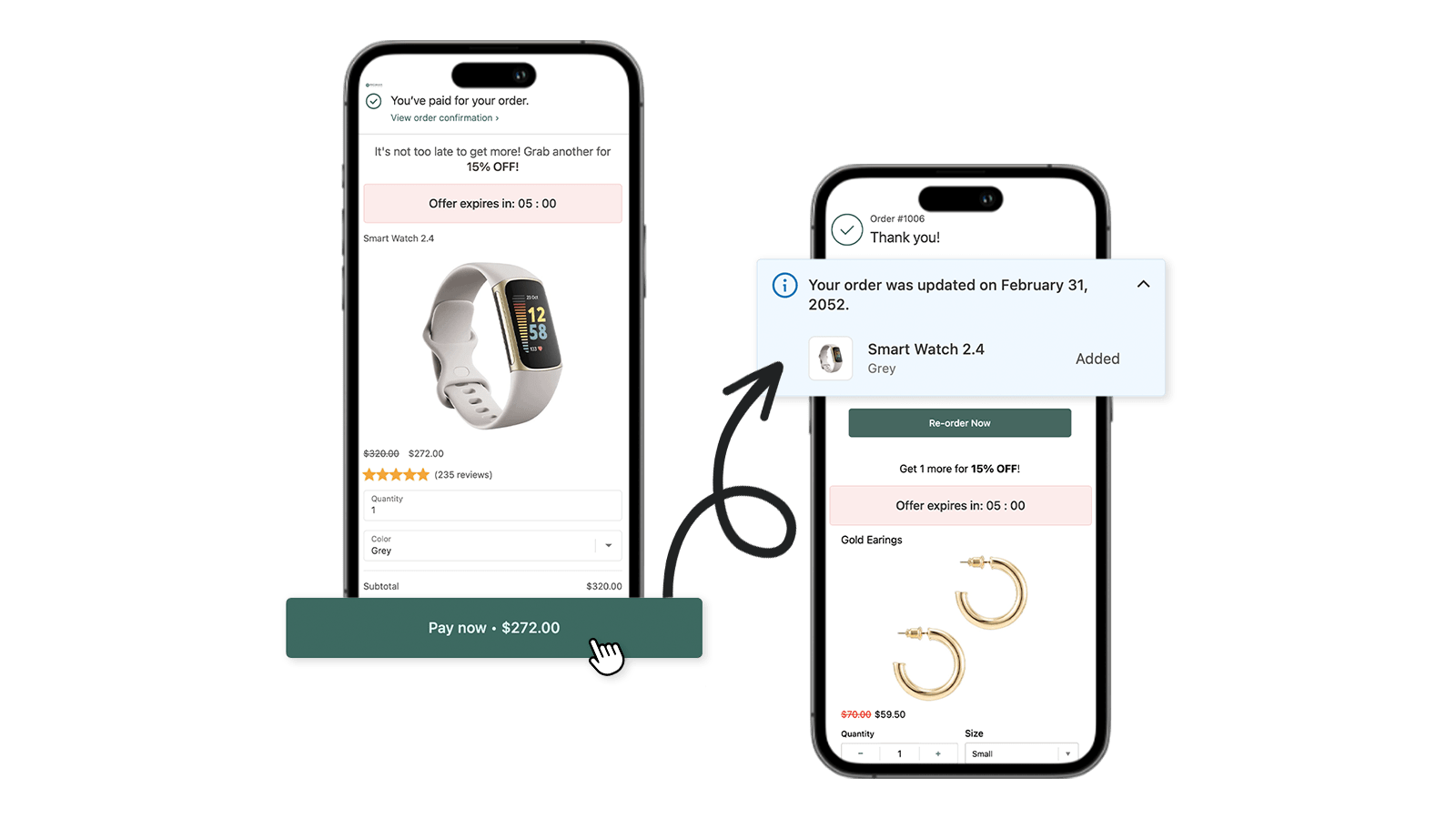
We’ve seen ReConvert users edit theirShopify checkout flowlike this and get crazy high conversion rates on these offers—sometimes converting up to 15% of its total order volume into second purchases.
22. Cross-sell on your thank you page
Once your customers complete their purchase, they land on yourthank you page, which is the ideal place to cross-sell related items and generate even more revenue. Seriously, a customer who’s just bought from you is highly likely to do it again if you give them the chance. Plus, data from our ReConvert suggests that customers come back to view your thank you page 2.2 times per order on average.
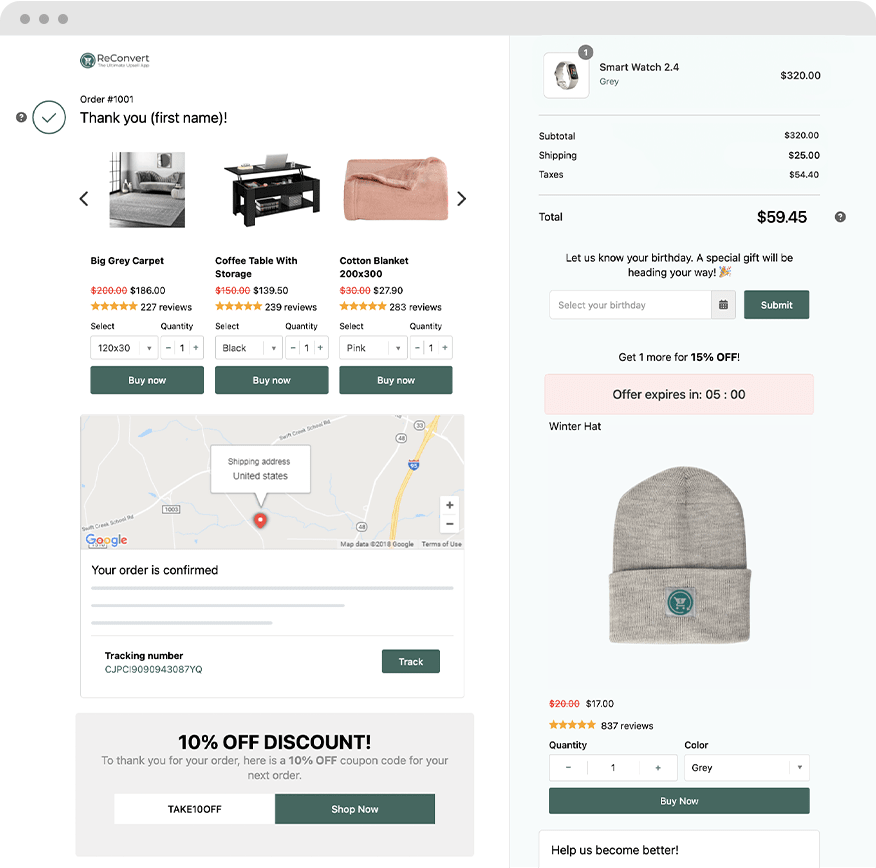
Suggesting personalized products based on your customer’s cart and their purchase history will helpdrive more sales.
And if you pair your post purchase offer with an element of scarcity, such as a limited time offer, you’ll see your post-purchase conversions (and revenue) go through the roof.
What is the average eCommerce conversion rate?
Overall, the average reported eCommerce conversion rate is around1.5-2%. But while industry benchmarks can be useful, putting too much faith in universal conversion rates is a mistake. This is because your conversion rate is influenced by factors beyond your store’s experience, such as:
Market & Audience:Different markets display different characteristics. For example, if you’re selling in a market where there’s comparatively low credit card penetration, you can expect your conversion rates to be lower when compared with similar stores in markets with higher penetration.
Price Point:Store’s selling lower priced goods will typically have higher conversion rates than those with more expensive goods, even in the same vertical. For example, H&M may have a higher conversion rate than Gucci because H&M’s products typically fall into the impulse-buy price range.
Traffic Source:Stores that drive the traffic from email or social media accounts will usually have higher conversion rates than store’s that rely on paid ads. It’s not that one source is better than the other, it’s just that shoppers from email or social media are already familiar with the brand. While traffic from paid ads is often coming in cold.
So yes, eCommerce conversion rate benchmarks are useful, but you must understand them in the context of your store.
As a general guideline, analytics platformLittleDataanalyzed over 3,000 Shopify stores and found a 1.3% average conversion rate.
In the report, a CVR of above 3.2% puts you in the top 20% of stores, while a rate of below 0.2% puts you in the bottom 20% of stores.
So from these figures, if your conversion rate is below 0.5%, you have room for improvement. Then if your store converts above 3.2%, trying to boost your conversion rate higher may yield diminishing returns.
How to improve your eCommerce conversion rate
One of the best ways to understand CRO is to view your store through the lens ofChris Goward’s (simplified) LIFT framework:
Value Proposition:Your value proposition is the most important for conversions. When you have a great product that meets the customer's needs, you can have an unoptimized store and still get good conversions. So browse your site and ensure visitors understand what your product is and why they need to buy it.
Friction:摩擦杀死转换。任何你shopp的一部分ing experience that generates friction prevents shoppers from completing their purchase. Things like unexpected shipping fees, slow loading pages, and long forms cause psychological friction.
Anxiety:Consumers know online shopping isn’t risk-free. They may worry the dress won’t fit, or that it won't arrive on time. Building trust with social proof, shipping details, a generous return policy, and fully encrypted payment gateway reduces anxiety and drives more conversions.
Urgency:How many times have you put off a purchase because you can do it later? If you’re like most people, the answer is lots. Subtly adding a sense of urgency to your customers experience with things like time-limited sales and stock counters encourages customers to buy now, rather than wait till later (which usually means never).
It's time to increase your eCommerce conversion rate
Boosting your eCommerce conversions can be challenging. However, with the right approach, and expertise, it’s possible to make changes that completely change your businesses profitability.
While the reported average eCommerce conversion rate is around 1.5-2%, it's important to remember that universal conversion rates are influenced by various factors beyond your store's experience, such as market and audience, price point, and traffic source. When making gains in your conversion rate, focus on:
Communicating your USP
Addressing your customer’s anxiety
Removing unnecessary friction points
Adding a sense of urgency
While most merchants can make modest CVR improvements on their own, it’s also wise to treat CRO like any other area of your business that’s worth investing in.
Enlisting the help of a professional can yield faster and more impressive results, while avoiding common pitfalls.
So if you’re keen to start, check out Fiverr’s awesome community ofCRO professionalsto help you implement the best strategies that’ll drive real results for your business.

